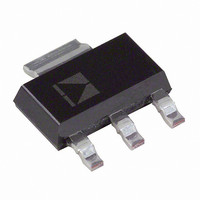ADP3339AKC-5-REEL7 Analog Devices Inc, ADP3339AKC-5-REEL7 Datasheet - Page 10

ADP3339AKC-5-REEL7
Manufacturer Part Number
ADP3339AKC-5-REEL7
Description
IC REG LDO 1.5A 5V SOT-223
Manufacturer
Analog Devices Inc
Series
anyCAP®r
Datasheet
1.ADP3339AKCZ-3.3-R7.pdf
(12 pages)
Specifications of ADP3339AKC-5-REEL7
Rohs Status
RoHS non-compliant
Design Resources
USB Hub Isolator Circuit (CN0158)
Regulator Topology
Positive Fixed
Voltage - Output
5V
Voltage - Input
Up to 6V
Voltage - Dropout (typical)
0.23V @ 1.5A
Number Of Regulators
1
Current - Output
1.5A
Operating Temperature
-40°C ~ 85°C
Mounting Type
Surface Mount
Package / Case
SOT-223 (3 leads + Tab), SC-73, TO-261
Current - Limit (min)
-
Other names
ADP3339AKC-5REEL7
ADP3339AKC-5REEL7
ADP3339AKC-5RL7TR
ADP3339AKC-5REEL7
ADP3339AKC-5RL7TR
ADP3339
APPLICATIONS INFORMATION
CAPACITOR SELECTION
Output Capacitor
The stability and transient response of the LDO is a function of
the output capacitor. The ADP3339 is stable with a wide range
of capacitor values, types, and ESR (anyCAP). A capacitor as low as
1 μF is all that is needed for stability. A higher capacitance may
be necessary if high output current surges are anticipated, or if
the output capacitor cannot be located near the output and
ground pins. The ADP3339 is stable with extremely low ESR
capacitors (ESR ≈ 0) such as multilayer ceramic capacitors
(MLCC) or OSCON. Note that the effective capacitance of
some capacitor types falls below the minimum over tempera-
ture or with dc voltage.
Input Capacitor
An input bypass capacitor is not strictly required but is recom-
mended in any application involving long input wires or high
source impedance. Connecting a 1 μF capacitor from the input
to ground reduces the circuit’s sensitivity to PC board layout
and input transients. If a larger output capacitor is necessary, a
larger value input capacitor is also recommended.
OUTPUT CURRENT LIMIT
The ADP3339 is short-circuit protected by limiting the pass
transistor’s base drive current. The maximum output current is
limited to about 3 A. See Figure 16.
THERMAL OVERLOAD PROTECTION
The ADP3339 is protected against damage due to excessive power
dissipation by its thermal overload protection circuit. Thermal
protection limits the die temperature to a maximum of 160°C.
Under extreme conditions (that is, high ambient temperature
and power dissipation) where the die temperature starts to rise
above 160°C, the output current is reduced until the die tempera-
ture has dropped to a safe level.
Current and thermal limit protections are intended to protect
the device against accidental overload conditions. For normal
operation, the device’s power dissipation should be externally
limited so that the junction temperature does not exceed 150°C.
CALCULATING POWER DISSIPATION
Device power dissipation is calculated as follows:
where I
and V
Assuming worst-case operating conditions are I
I
dissipation is
P
GND
D
= (3.3 V – 2.5 V) × 1500 mA + (3.3 V × 14 mA) = 1246 mW
= 14 mA, V
P
IN
D
LOAD
= (V
and V
and I
IN
OUT
– V
IN
GND
are the input and output voltages, respectively.
OUT
= 3.3 V, and V
are the load current and ground current,
) × I
LOAD
+ (V
OUT
IN
× I
= 2.5 V, the device power
GND
)
LOAD
= 1.5 A,
Rev. B | Page 10 of 12
Therefore, for a junction temperature of 125°C and a maximum
ambient temperature of 85°C, the required thermal resistance
from junction to ambient is
PRINTED CIRCUIT BOARD LAYOUT
CONSIDERATIONS
The thermal resistance, θ
sum of the junction-to-case and the case-to-ambient thermal
resistances. The junction-to-case thermal resistance, θ
determined by the package design and specified at 26.8°C/W.
However, the case-to-ambient thermal resistance is determined
by the printed circuit board design.
As shown in Figure 22, the amount of copper onto which the
ADP3339 is mounted affects thermal performance. When
mounted onto the minimal pads of 2 oz. copper (see Figure 22a),
θ
ADP3339 (see Figure 22b) reduces the θ
Increasing the copper pad to 1 square inch (see Figure 22c)
reduces the θ
Use the following general guidelines when designing printed
circuit boards:
1.
2.
3.
4.
5.
6.
JA
is 126.6°C/W. Adding a small copper pad under the
Keep the output capacitor as close to the output and
ground pins as possible.
Keep the input capacitor as close to the input and ground
pins as possible.
PC board traces with larger cross sectional areas remove
more heat from the ADP3339. For optimum heat transfer,
use thick copper and use wide traces.
The thermal resistance can be decreased by adding a
copper pad under the ADP3339, as shown in Figure 22b.
If possible, use the adjacent area to add more copper
around the ADP3339. Connecting the copper area to the
output of the ADP3339, as shown in Figure 22c, is best, but
thermal performance is improved even if it is connected to
other pins.
Use additional copper layers or planes to reduce the
thermal resistance. Again, connecting the other layers to
the output of the ADP3339 is best, but is not necessary.
When connecting the output pad to other layers, use
multiple vias.
θ
a
JA
=
125
JA
. 1
°
even further, to 52.8°C/W.
246
C
−
85
W
b
°
Figure 22. PCB Layouts
C
JA
=
, of SOT-223 is determined by the
32
1 .
°
C/W
JA
to 102.9°C/W.
c
JC
, is













